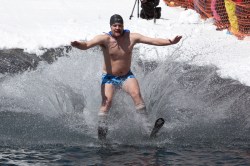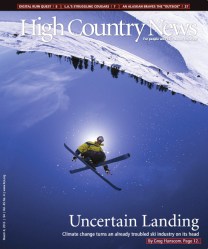
TenSafeFrogsChipper up, shredders, there’s always pond skimming …
Ask any pack of bona fide shredders about their exploits on the slopes last winter, and they’re apt respond, “Winter? What winter?”
The winter of 2011-12 was one of the warmest, driest winters on record in North America. The skiing and snowboarding was so bad — and the weather in coastal cities so mild — that many avid powder hounds just sat it out.
I wrote about the devastating season for the latest issue of High Country News. The story is based in Mammoth Lakes, Calif., home to Mammoth Mountain Ski Area, Southern California’s beloved snow sports Shangri-La:
After early storms that got the lifts running in time for the Thanksgiving 2011 rush, Mammoth was socked with a merciless dry spell. Nary a flake fell between Dec. 1 and the end of January. Just over the usually snowbound Tioga Pass, people were ice-skating on the snow-free surface of Yosemite National Park’s Tenaya Lake — for the first time since 1930, old-timers said.
Mammoth Mountain’s notorious winds, meanwhile, scattered volcanic pumice across the ski runs. “There were a couple of days when you just said, ‘Wow, that was the worst skiing I have ever experienced,’ ” says Craig Albright, managing director of the resort’s ski and snowboard school.
At the end of February, the ski area laid off 77 employees, almost a quarter of its full-time staff. Locals called it Black Wednesday. And as the ski resort went, so went the town, where lodging and sales taxes are the bread and butter. On July 3, battered by the hard winter and hobbled by a string of bad decisions stretching back over more than a decade, Mammoth Lakes declared bankruptcy.
When I visited in December, the community was picking itself up and dusting itself off. This winter has been better for the town and the ski resort. But the story offers a look at what climate change has in store for ski towns — and some of our beloved winter pastimes.
Studies conducted by University of Colorado snow scientist Mark Williams and his colleagues predict that, if we continue to pollute the way we do now, skiing will be confined to the top quarter of Aspen Mountain in average years by the end of the century. Utah’s Park City Mountain Resort will have no snowpack whatsoever. The Great Melt will hit maritime ski resorts in the Cascades and Sierra even sooner. A study in New England found that only four of the region’s 14 major ski resorts will still be profitable by 2100 — if they even survive that long.
Given the prognosis, you’d think that ski industry leaders would be screaming for action on climate change. With a few notable exceptions, you would be wrong.
Last March, a group of industry insiders sent a letter to the trade groups that are charged with promoting skiing around the country and lobbying for its interests in Washington, D.C., begging them to act before it’s too late.
“We believe strong national climate policy … should be a primary focus of industry trade groups,” said the letter, which was signed by the CEOs of Powdr Corp, Aspen Skiing Co., clothing manufacturers Patagonia and The North Face, professional snowboarders, and others. “We know this year’s dry season can’t be solely attributed to climate change. But the extreme variability of the weather, and increasingly violent storms, are exactly what climatologists predict in a warming world. 2011 gave us a taste of that future, what PBS recently called ‘mind-boggling extreme weather’ resulting from warming, what meteorologist Dr. Jeff Masters called ‘steroids for the atmosphere.’”
The response from the trade groups was tepid. The National Ski Areas Association has created a program called the Climate Challenge that encourages resorts to reduce greenhouse gas emissions, and it has advocated for clean energy programs on the national level. Many individual resorts have cleaned up their operations by shifting to renewables like wind power. But when it comes to the larger fight against climate change, most industry bigwigs would rather watch quietly from the sidelines.
“It’s a tough reality to swallow,” Elizabeth Burakowski, a PhD candidate in snow science at the University of New Hampshire, told me. “It’s bad for business.”
Burakowski co-authored a study [PDF], released in December, about global warming’s disastrous economic impacts on the ski business. It was commissioned by two environmental groups — the Natural Resources Defense Council and Protect Our Winters (aka POW), which was founded by professional snowboarder Jeremy Jones to raise awareness of climate change — and it got the same response from the industry as that letter from the CEOs: Yes, climate change is a problem, but let’s just leave skiing out of it, shall we?
To be fair, the ski biz has plenty to worry about as it is. This is from a sidebar to my Mammoth story:
Nationally, the number of visits to ski resorts has remained essentially flat since the industry started keeping track in 1979. Analysts blame younger people, who aren’t replacing aging Baby Boomers, the ski industry’s main market. And now comes the news that snowboarding, a sport largely credited for saving the industry in the 1990s, is on a steep downhill slide. A report released this winter by RRC Associates, a company that tracks winter recreation, found that the percentage of snowboarding visits to ski areas has declined over the past two years, while the number of days boarders head to the mountain has dropped sharply in the past decade.
I know that the industry has brought many of these hardships on itself, but I grew up in a ski town, so I sympathize with those who are struggling mightily to keep the business, and their communities, alive. I also love skiing. I’m teaching my two young daughters the joys of sliding around in the snow.
I’ve come to accept that this is a dying pastime — my kids will ski, and maybe their kids, but beyond that, there simply won’t be enough snow, at predictable times of year, to support anything close to the kind of skiing that I’ve enjoyed.
In the meantime, however, it would be nice if there were more visionaries in the $66 billion winter sports business — more people like heads of Powdr Corp., Aspen Ski Co., Patagonia, and The North Face — who are willing to sound the alarm about climate change, and put their economic heft into pushing for action. Skiing as we know it may be doomed, but there’s still plenty to fight for.




